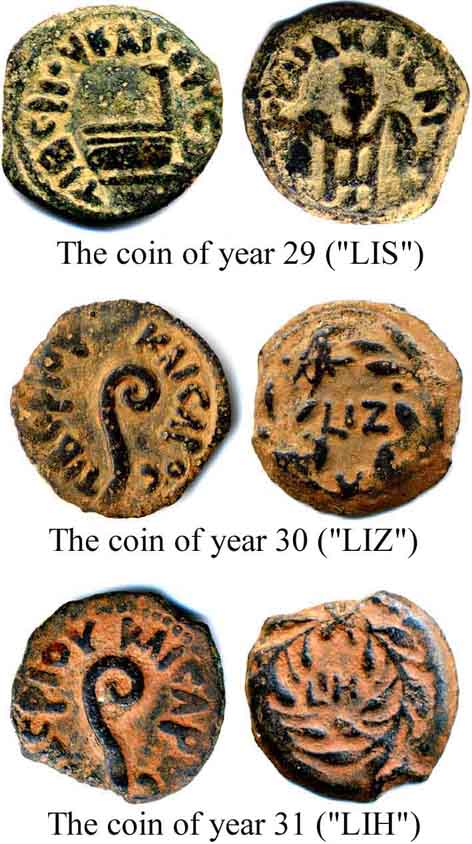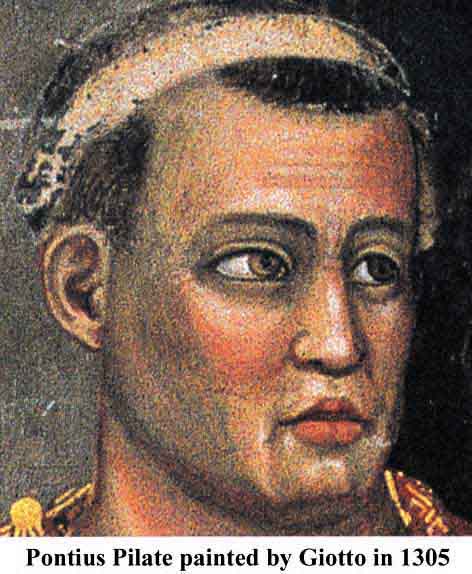Jean-Philippe Fontanille
Traduction non-professionnelle: cocotte
1. INTRODUCTION
Elles ne sont pas réellement belles, ni vraiment rares, non-plus sont elles de très grande valeur monétaire. Pourtant, ces pièces apparemment modestes apportent avec leur poids une ère et une action qui aurait une immense conséquence sur l'histoire du monde. En fait, elles sont associées de près avec trois facteurs de base qui ont vu la fondation de la Chrétienneté:
1 - La prominité temporelle : La plupart des experts modernes sont d'accord pour reconnaître que l'année maintenant désignée de 30 C.E. a marqué la procès et la mort de Jésus. Convenant de cet encadrement dans le temps, les pièces de monaies de Pilate furent frappées en 29, 30 et 31 C.E.
2 - La proximité géographique : L'hypothèse la plus crédible indiquerait que ces pièces en particulier furent frappées à Jérusalem, la cité dans laquelle les évènement significatifs eurent lieu.
3 - La proximité humaine : Ponce Pilate lui-même a créé le motif et a émis les pièces en circulation, et évidemment, il était l'homme qui a conduit le procès et a ordonné la crucification de Jésus.
Donc, c'est que tout le monde, soit un croyant ou un amant de l'histoire tout simplement ou du numismatisme, vont y trouver dans ces pièces une preuve de et un témoignage d'une épisode dont sa mémoire a survécu pendant 2000 années : un évènement capital qui a façonné en grande partie le monde que nous connaissons.
Partout dans cet article, nous allons aussi noter le charactère exceptionnel des pièces de Pilate: Exceptionnelles dans la nature des images qu'elles portent, pour les variantes nombreuses qu'elles offrent, pour la présence de marques (countermarks ?), et pardessus tout autre chose, pour le rôle que leur originateur a joué dans l'histoire. L'apparence putative de ces pièces empreinte sur le suaire de Turin reste encore à être confirmer par des preuves scientifiques plus solides.
Les Pièces de Pilate sont des pièces Romaines, les mots sur elles sont Grecs, ils furent circulées en Judée, et aujourd'hui nous les retrouvons distribuées parmis des collecteurs mondiaux après avoir passé 2000 années enterré sous la terre. Elles furent battuent et utilisées durant une période qui a produit un évènement détiné à changer le visage du monde, et émisent sous le commandement d'un des acteurs principales de cet évènement. Une destinée étonnante et dramatique pour de pareilles pièces apparemment humbles et modestes !
Pendant 35 années, les pièce de Pilate furent passées de mains en mains à chaque jour. Elles ont connu les senteurs des étals à épices, entenduent les déblatérages des marchants, ont senti de sueur et de poussière du travail quotidien. Elles étaient du temps où les bruits de voix en Hébreux, en Aramaique, en Grec et en Latin maintenant marchandant le prix, maintenant offrant des prières à YHVH, Jésus ou Jupiter.
Personne ne prient à Jupiter maintenant, mais les pièces de Pilate survivent les témoins d'une époque lorsque les premiers Chrétiens étaient considérés comme étant une secte messianique parmis plusieurs autres dans une brume de Judaisme en crise. La cision absolue entre le Judaisme et la Chrétienneté eu lieu d'allentour de 70 C.E., l'année qui marqua la fin tragique de la première rébellion Juive. Ce fut de ce temps, aussi, que l'argent de Pilate a cessé d'être utiliser.
Comme chacun de nous, qui transportent toujours quelques petites pièces dans le fond de nos poches; il n'y a aucun doute que des pièces de Pilate résonnaient aux derniers mots du plu célèbre de tous le supplicants. Une très longue histoire a eu son commencement...
2. LA MANUFACTURE ET LA CIRCULATION
LA LOCATION DES HÔTELS DE LA MONAIS
la traduction à être compléter !
Although the prefects had their residencies in Cesarea, the administrative capital of the province, it seems that their money was minted in Jerusalem. Indeed, a specimen dated year 31 has been found in this town in an incomplete state of manufacture.
DURATION OF USE
It would seem that Pilate's money was in current use for at least 35 years. Indeed, some of it has been discovered among other coins during the excavation of remains of dwellings destroyed by the Romans during the first Jewish revolt, which is evidence that they were still in use at that time.
AREA OF CIRCULATION
These coins circulated far beyond the frontiers of Judea. Some samples have been discovered as far away as Antioch in present-day Turkey, nearly 500 kilometres from Jerusalem where they were minted. Others have also been found in Jordan. These limits represent a circulation area of at least 100.000 square kilometres, that is five times larger than the size of the state of Israel. Taking into account that it was a time when distances were expressed in terms of days of march, one begins to see the important influence of these coins.
3. THE IMAGES AND THE TEXTS
THE SIMPULUM
A fairly frequent symbol from the Roman religion of the time, the simpulum was a utensil used by the priests during their religious ceremonies. This little ladle, provided with shaft and a handle, allowed the priests to taste the wine which they poured onto the head of an animal destined for sacrifice, after which the soothsayer was empowered to examine the animal's entrails for signs and portents sent to men by the Gods through the medium of the interpreter. As I pointed, none of this would have been obvious at first sight of the motif except perhaps to a Roman citizen. However, it throws some light on the theory put forward by F.A. Banks.
This wasn't the first time that the simpulum appeared on Roman coins, but it is the first time it figured alone. This fact gives an additional specificity to Pilate's coins, not only in the context of Judea but also in comparison with all the other coins of the Empire.
THE THREE EARS OF BARLEY
The three ears or barley are featured on the opposing face of the simpulum. Unlike the simpulum, these ears of barley are not in contravention of the Jewish Law. The motif is nevertheless distinctive because it is the first time it appears on a Judean coin. The motif would reappear twelve years later on one of Herod Agrippa's coin, then on another, much rarer, of Agrippa II (ears of barley held in a hand). After that, the motif disappeared altogether from ancient Jewish coins.
THE LITUUS
The lituus was the wooden staff which the augurs held in the right hand; it symbolised their authority and their pastoral vocation. It was raised toward heavens while the priests invoked the Gods and made their predictions. Legend records that Romulus used it at the time of Rome's foundation in 753 B.C.E. It is interesting to note that the cross used in present times is the direct descendant of the lituus. As with the simpulum, Pilate's coinage is exceptional in that it alone displays the lituus as the sole object illustrated on the face.
THE WREATH
The laurel wreath is a symbol of power and victory, and figures on various ancient Greek and Roman coins. In Judea it can be found during the reign of John Hyrcanus I (134 to 104 B.C.E.). After that, Herod Antipas, speaker for Pilate, used it on all his coins. On Pilate's coins, the laurel wreath figures on the reverse side of the lituus, framing the date.
THE DATES
The notation of dates uses a code invented by the Greeks whereby each letter of the alphabet was assigned a number. This code would be used again in Judaism under the name of Guematria. The system is simple : the first ten letters of the alphabet are linked to units (1,2,3...), the following ten letters to tens (10,20,30...) and the four remaining letters to the first four hundreds. The "L" is an abbreviation meaning "year". Tiberius became emperor on September 17 of year 14 C.E, so we have :
LIS = Year 29 C.E. * LIZ = Year 30 C.E. * LIH = Year 31 C.E.
THE TEXTS
The legends on Pontius Pilate's coins are written in Greek. Judea, governed by the Ptolemy dynasty (301 to 198 B.C.E) then by the Syrians until 63 B.C.E, came under the same powerful influence of the Hellenic culture which touched the other territories of the ancient Persian Empire won by Alexander the Great. In spite of a certain amount of resistance, this Hellenistic heritage eventually crept into every aspect of daily life. Apart from the dates, the texts on Pilate's coinage consisted of only three different words : - TIBEPIOY KAICAPOC (Of Tiberius Emperor) on all three coins; - IOYLIA KAICAPOC (Empress Julia) added to the coin of year 29.

